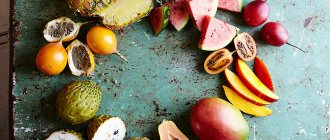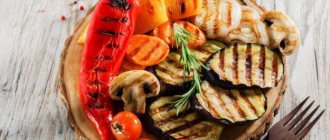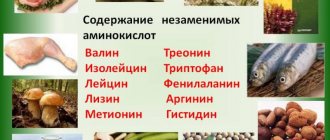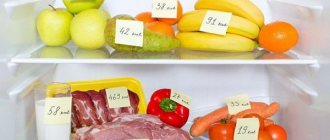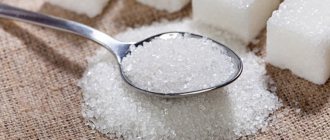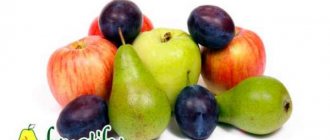From early childhood we hear that vegetables, fruits and greens are very beneficial for our health. This statement is true, because these food products contain many vitamins, minerals (micro- and macroelements) and other important substances necessary for the normal development and functioning of the body. Vegetables, fruits and greens contain a minimum of calories, so nutritionists recommend that all people who are struggling with excess weight, watching their figure and leading a healthy lifestyle, introduce these foods into their diet.
But low calorie content is not the most important indicator. When drawing up a dietary menu, it is necessary to take into account such important aspects as the glycemic index and glycemic load. It is these indicators that help you understand how quickly carbohydrates are broken down and how quickly they are absorbed by the body.
Do you want to know which vegetables, fruits and greens promote weight loss and are good for our health, and which ones should not be consumed if you dream of a thin waist and tummy without an extra gram of fat? Just look at the calorie table for vegetables, fruits and herbs, which we created especially for you.
Calorie content, glycemic index and glycemic load of vegetables and fruits
Calorie content is a very important, but far from the only indicator that needs to be taken into account when creating an individual diet.
Calorie content should be considered in conjunction with the glycemic index (GI) and glycemic load (GL).
The glycemic index is the rate at which blood sugar levels rise after eating a certain food. The lower the GI, the slower the blood sugar level rises after consuming the product. A high GI promotes the rapid production of insulin in large quantities, thanks to which you get a lot of energy and strength in a short period of time after eating. If you are waiting for an intense workout in the gym, then there is nothing wrong with eating a vegetable or fruit that has a high GI. If you rest passively, then the excess energy that is not useful to you will be converted and stored in the body in the form of fat deposits.
Glycemic load is an indicator that demonstrates the speed, intensity and duration of changes in blood sugar levels. Thanks to GN, you can understand which vegetables and fruits will keep your blood sugar levels down for the longest time so that you can exclude them from your diet.
The lower the level of the glycemic index and glycemic load, the fewer calories that enter the body will remain in it in the form of extra pounds and centimeters on the waist. Thus, people who are losing weight and leading a healthy lifestyle are not recommended to eat potatoes, because they not only contain a lot of calories, but also have a high GI, the level of which increases even more when cooked.
Sweet and ripe fruits contain more calories and sugar than slightly unripe fruits. Therefore, give preference to fruits that are not too sweet and slightly unripe, which contain a lot of dietary fiber (fiber) and little sugar.
After heat treatment, the rate of energy release from carbohydrates increases significantly, since dietary fiber is greatly destroyed during cooking. Because of this, complex carbohydrates are transformed into simple ones. The body has to spend much more energy processing complex carbohydrates, which saturate the body slowly and gradually, than processing simple carbohydrates. Therefore, eat as many vegetables and fruits as possible in their raw form.
You should not chop vegetables or fruits very finely, because the speed of their absorption by the body depends on the size of the chopped pieces. Dietary fiber, which slows down the breakdown of carbohydrates, is destroyed when crushed. Therefore, it is recommended to eat fruits and vegetables whole or cut into large pieces.
https://youtu.be/https://www.youtube.com/watch?v=DaL4GzlO024
_
Foods with the highest carbohydrate content
Carbohydrates in food products, the table of which provides all the necessary information about the amount of their content, allow the body to function without failures.
Foods high in carbohydrates should be consumed in small proportions, and in the process of losing weight it is better to abandon them altogether, since such food quickly satisfies hunger, but it does not last long. The person will want to have something to eat again. And this process is constantly repeated, causing dependence on simple carbohydrates.
Fast-digesting foods high in sugar:
| Glycemic index | Food |
| 70-74 |
|
| 75-79 |
|
| 80-84 |
|
| 85-89 |
|
| 90-94 |
|
| 95-99 |
|
| 100-110 |
|
| 140 |
|
High glycemic index foods are best used during and after strenuous exercise and when blood sugar levels are low.
Calorie table for vegetables and greens per 100 grams
| No. | Name of vegetable or herb | Number of calories per 100 g | Quantity of used / used per 100 g | GI | GN |
| 1. | Celery | 12 | 1 / 0 / 2 | 15 | 0,3 |
| 2. | Leaf salad | 14 | 1 / 0 / 2 | 10 | 0,3 |
| 3. | Cucumber | 15 | 1 / 0 / 2 | 15 | 0,3 |
| 4. | Chinese cabbage | 16 | 1 / 0 / 3 | 15 | 0,4 |
| 5. | Zucchini | 17 | 2 / 0 / 2 | 15 | 0,8 |
| 6. | Green onions | 19 | 1 / 0 / 5 | 15 | 1,1 |
| 7. | Zucchini | 19 | 1 / 0 / 5 | 15 | 0,8 |
| 8. | Radish | 20 | 1 / 0 / 3 | 15 | 0,5 |
| 9. | Asparagus | 20 | 2 / 0 / 3 | 15 | 0,6 |
| 10. | Spinach | 22 | 3 / 0 / 2 | 15 | 0,4 |
| 11. | Tomatoes | 23 | 1 / 0 / 4 | 30 | 1,3 |
| 12. | Eggplant | 24 | 1 / 0 / 7 | 20 | 1,1 |
| 13. | Bell pepper | 27 | 1 / 0 / 6 | 15 | 0,8 |
| 14. | Artichokes | 28 | 1 / 0 / 6 | 20 | 1,2 |
| 15. | White cabbage | 28 | 2 / 0 / 5 | 15 | 0,6 |
| 16. | Cauliflower | 28 | 0 / 0 / 5 | 15 | 0,6 |
| 17. | Pumpkin | 29 | 1 / 0 / 8 | 65 | 3,4 |
| 18. | Broccoli | 33 | 4 / 2 / 5 | 15 | 0,7 |
| 19. | Fresh carrots | 33 | 1 / 0 / 4 | 30 | 1,8 |
| 20. | Dill | 38 | 2 / 0 / 6 | 5 | 0,4 |
| 21. | Chilli | 40 | 2 / 0 / 10 | 15 | 1,2 |
| 22. | Beet | 40 | 2 / 0 / 9 | 30 | 2,7 |
| 23. | Bulb onions | 41 | 1 / 0 / 10 | 15 | 1,4 |
| 24. | Brussels sprouts | 43 | 5 / 0 / 8 | 15 | 0,9 |
| 25. | Parsley | 45 | 4 / 0 / 8 | 5 | 0,4 |
| 26. | Boiled potatoes | 80 | 2 / 0 / 18 | 65 | 10,9 |
| 27. | Ginger | 80 | 2 / 1 / 16 | 15 | 2,1 |
| 28. | Olives | 115 | 1 / 11 / 6 | 15 | 0,9 |
| 29. | Boiled corn | 123 | 4 / 2 / 24 | 70 | 15,7 |
| 30. | Garlic | 146 | 6 / 0 / 30 | 30 | 9 |
| 31. | Olives | 166 | 2 / 16 / 5 | 15 | 0,8 |
Calorie content of baked and stewed vegetables
Many vegetables are cooked before eating. Exposure to heat affects the calorie content of the product. For boiled vegetables, the calorie content changes slightly: for some it increases, for some it even decreases. You can compare the number of calories (per 100 grams of product) of boiled vegetables with the previous table.
- Boiled eggplant – 33-35
- sweet potato – 76
- broccoli – 35
- rutabaga – 30
- Brussels sprouts – 36
- zucchini – 20
- kale – 44
- white cabbage – 24
- cauliflower – 23
- jacket potatoes - 80-87
- kohlrabi – 30
- watercress – 24
- corn – 95
- onions – 40-45
- carrots – 33
- squash – 20
- sweet pepper – 25-30
- beets – 50
- asparagus – 23
- pumpkin – 16-22
- zucchini – 15
- spinach – 24
- sorrel – 20
During cooking, the beneficial qualities of the product decrease, but not so much as to abandon this method of preparation.
For baked vegetables, the calorie content per 100 grams of product also changes little if oil or fat is not added during the baking process. For baking, foil and a special sleeve are used. Nutrients are preserved better.
The calorie content of stewed vegetables depends on the method of preparing the dish and the amount of oil used. Vegetables tend to absorb oil, which significantly increases the calorie content of stewed vegetables. The number of calories in stewed zucchini will increase to 70-90, white cabbage - up to 50, potatoes - up to 190.
The benefits of vegetables and fruits for the human body
Most vegetables and fruits contain virtually no fat and consist of dietary fiber (fiber). Dietary fiber is necessary for the body to improve the functioning of the gastrointestinal tract, normalize and speed up metabolism. Fiber helps the body naturally remove waste, toxins and excess fluid.
Vegetables and fruits contain many vitamins (B vitamins, vitamin A, vitamin C, vitamin E, vitamin K, vitamin H, vitamin PP, etc.), minerals (magnesium, manganese, calcium, zinc, potassium, copper, selenium, fluorine, iron, molybdenum, iodine, vanadium, cobalt, phosphorus, etc.) and other substances beneficial to our body.
Vegetables with negative calories
The unusual combination of “negative calories” is due to the fact that foods with a low amount of calories - no more than 30 per hundred grams - during their processing by the body cannot provide even the amount of energy that is spent on digestion. To digest one hundred grams of green salad with a calorie content of 15 kcal, you need to spend an average of 130 kcal. A person receives less energy than he spends.
List of negative calorie vegetables.
- Cucumbers. You can eat vegetables in any quantity and not be afraid that it will negatively affect your figure. 10-15 calories per hundred grams of product will be burned at the very beginning of food processing. A cucumber consists of 97% water, the rest is only useful vitamins, substances, and fiber.
- Celery. An excellent addition to vitamin-rich low-calorie salads. One hundred grams of celery contains only 13-16 kcal.
- Ginger. Ginger's calorie content is not low - 80 kcal per 100 grams. The benefit of the product for weight loss is that when it is consumed, the body produces heat, which means that excess energy is expended.
- Spinach. 24 kcal per hundred grams is the calorie content of spinach. The vegetable contains folic acid, magnesium, vitamins, and other beneficial substances.
- Parsley. The figure will be grateful for the consumption of parsley, which contains only 30 kcal per hundred grams. Parsley contains a lot of magnesium, antioxidants, and vitamins.
- Kelp. Sea kale contains about 50 kcal per hundred grams. It is rich in vitamins and minerals necessary for the body.
All types of salads, cabbage, asparagus, zucchini, tomatoes, and carrots have negative calorie content. There are few calories in radishes, turnips, beets, and onions. The lowest calorie vegetable is cucumber. The highest calorie food is potatoes.
To preserve the beneficial properties of vegetables, it is best to consume foods raw. And calorie content can always be calculated using a table. For example, 100 grams of fresh tomato salad with the addition of a small amount of vegetable oil contains 60-65 kcal. The taste of the salad can be supplemented with garlic and basil.
Calorie table for fruits per 100 grams
| No. | Fruit name | Number of calories per 100 g | Quantity of used / used per 100 g | GI | GN |
| 1. | Lemon | 16 | 1 / 0 / 3 | 20 | 20,6 |
| 2. | Watermelon | 27 | 0 / 0 / 8 | 75 | 6,6 |
| 3. | Cranberry | 28 | 0 / 0 / 4 | 45 | 3,1 |
| 4. | Grapefruit | 29 | 1 / 0 / 10 | 25 | 2,4 |
| 5. | Strawberry | 30 | 1 / 0 / 7 | 25 | 2 |
| 6. | Strawberries | 30 | 1 / 0 / 7 | 25 | 2 |
| 7. | Mandarin | 33 | 1 / 0 / 8 | 30 | 3 |
| 8. | Cherry plum | 34 | 0 / 0 / 8 | 25 | 1,6 |
| 9. | Orange | 36 | 1 / 0 / 8 | 30 | 3 |
| 10. | Black currant | 36 | 1 / 0 / 7 | 15 | 1,1 |
| 11. | Melon | 38 | 0 / 0 / 7 | 65 | 4 |
| 12. | Red Ribes | 39 | 1 / 0 / 8 | 25 | 1,9 |
| 13. | Pear | 42 | 0 / 0 / 11 | 30 | 4 |
| 14. | Raspberries | 42 | 1 / 0 / 11 | 25 | 2,9 |
| 15. | Blackberry | 42 | 1 / 0 / 11 | 25 | 2,9 |
| 16. | Plum | 42 | 1 / 0 / 10 | 30 | 2,4 |
| 17. | Gooseberry | 43 | 1 / 0 / 12 | 25 | 4 |
| 18. | Blueberry | 44 | 1 / 0 / 11 | 25 | 6 |
| 19. | Apricot | 46 | 1 / 0 / 11 | 35 | 2,5 |
| 20. | Peach | 46 | 1 / 0 / 11 | 35 | 3,5 |
| 21. | Apple | 47 | 0 / 0 / 10 | 35 | 4 |
| 22. | Nectarine | 48 | 1 / 0 / 12 | 35 | 3 |
| 23. | Kiwi | 48 | 1 / 0 / 10 | 50 | 5,5 |
| 24. | A pineapple | 49 | 0 / 0 / 11 | 50 | 7 |
| 25. | Cherry | 52 | 1 / 0 / 12 | 25 | 2,8 |
| 26. | Cherries | 52 | 1 / 0 / 12 | 25 | 2,8 |
| 27. | Pomegranate | 52 | 1 / 0 / 14 | 33 | 6,5 |
| 28. | Persimmon | 53 | 0 / 0 / 17 | 50 | 8 |
| 29. | Grape | 65 | 1 / 0 / 17 | 45 | 6,8 |
| 30. | Mango | 67 | 0 / 0 / 12 | 50 | 7 |
| 31. | Banana | 89 | 2 / 0 / 22 | 55 | 11 |
| 32. | Avocado | 208 | 2 / 20 / 7 | 10 | 0,2 |
| 33. | Coconut | 380 | 3 / 34 / 30 | 45 | 2,8 |
What determines the calorie content of fresh fruits?
Often, fresh fruits become the main food product during diets. This is very correct, because fruits are healthy, tasty and, most importantly for a diet, low in calories. There are some peculiarities in choosing fruits for a diet, and simply for people who do not want to receive energy into the body, which they probably do not use.
So, how can you determine with the naked eye what the calorie content is in fruit? There are several methods.
For comparison and a clear example, let’s take a banana and a watermelon. Less calories in watermelon. You can also consider a couple of fruits like melon and grapes. Less calories in melon. The calorie content of fruit largely depends on its composition and consistency. The more liquid in the fruit, the lower the calorie content of this product.
The amount of sugar in the product also greatly affects the calorie level. That is, the sweeter the fruit treat, the more energy it will release into the body.
If we take specific examples, then dried fruits have much more calories than fresh fruits . From what was discussed above, it can be understood that this is due to a minimal amount of moisture in the product and an increased level of sugar. Although, if you do not take into account the calorie content, then dried fruits are very healthy and should be eaten in moderation.
https://youtu.be/https://www.youtube.com/watch?v=616VPWdoDKA
_
High and low calorie fruits
It is quite clear that there are high and low calorie foods. If you take into account fruits, they can be divided into low-calorie and high-calorie.
High and low calorie fruits:
| High calorie fruits | |
| Bananas | 89 calories |
| Nectarine | 63 calories |
| Kiwi | 61 calories |
| Mango | 60 calories |
You can add to this list all fruits that are similar in consistency and sweetness. But from the table it is easy to understand which fruit has the highest calorie content.
| Low calorie fruits | |
| Grapefruit | 32 calories |
| Papaya | 43 calories |
| Lemon | 29 calories |
| Plum | 46 calories |
Low-calorie fruits are quite enough; these are the fruits that need to be eaten and included in the diet.
Healthy vegetable diet
If you eat vegetables at least 5 times a day, your body will be more resistant to various kinds of diseases. In addition, it has a positive effect on overall well-being. Unfortunately, the human body cannot accumulate useful vitamins and other elements. As an example, consider vitamin C. It is found in many natural foods and is easily absorbed. To maintain the required level of vitamin C in the body, you need to constantly take care of consuming foods containing this vitamin, such as peppers, broccoli, spinach, parsley, dill, Brussels sprouts, etc.
Helpful information
Almost all vegetables need to be stored in the refrigerator. The exception is unripe vegetables, because at room temperature they will become a little riper. Also, shelf-stable foods, such as potatoes and beets, are not required to be stored in the refrigerator, but it is advisable. The most convenient place in the refrigerator for vegetables is the bottom drawer. Many of them can be safely stored there for up to 1 month. But most vegetables are best used within a week. If you freeze or buy frozen vegetables, then rest assured, because... they remain tasty and healthy for a very long time - up to one year. Canned vegetables should be stored in a cool, dark place, the optimal temperature should be below 15 degrees.
